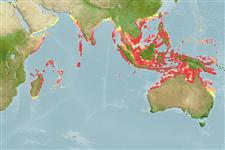Classification / Names
Common names from other countries
Main reference
Size / Weight / Age
Max length : 16.0 cm SL male/unsexed; (Ref. 188)
Length at first maturity
Lm 13.5 range ? - ? cm
Environment
Marine; freshwater; brackish; pelagic-neritic; anadromous (Ref. 51243); depth range 10 - 55 m (Ref. 12260)
Climate / Range
Tropical, preferred 28°C (Ref. 107945); 25°N - 30°S, 43°E - 155°E (Ref. 54703)
Distribution
Indo-West Pacific: Madagascar, and from Durban, South Africa to the Gulf of Oman and the coasts of India. From the Andaman Sea to Indonesia and the Philippines, southeast to the Arafura Sea (Ref. 9819), northern and western Australia and Papua New Guinea.
Countries | FAO areas | Ecosystems | Occurrences | Introductions
Short description
Dorsal
spines
(total): 0;
Dorsal
soft rays
(total): 0;
Anal
spines: 0;
Anal
soft rays: 34 - 42. Belly with usually 18 or 19 + 8 or 9, total 26 to 28 scutes, strongly keeled. Eye large, lower jaw projecting; and upper jaw with a toothed hypo-maxillary bone between hind tip of pre-maxilla and lower bulge of maxilla blade. Dorsal fin origin near midpoint of body. Scales with upper and lower vertical striae slightly overlapping each other at center of scales.
IUCN Red List Status (Ref. 115185)
Threat to humans
Harmless
Human uses
Fisheries: commercial; bait: usually
More information
ReferencesAquacultureAquaculture profileStrainsGeneticsAllele frequenciesHeritabilityDiseasesProcessingMass conversion
Tools
Special reports
Download XML
Internet sources
Estimates of some properties based on models
Phylogenetic diversity index
PD50 = 0.5156 many relatives (e.g. carps) 0.5 - 2.0 few relatives (e.g. lungfishes)
Trophic Level
4.0 ±0.7 se; Based on size and trophs of closest relatives
Resilience
High, minimum population doubling time less than 15 months (K=0.28-0.74)
Vulnerability
Low vulnerability (21 of 100)
Price category
